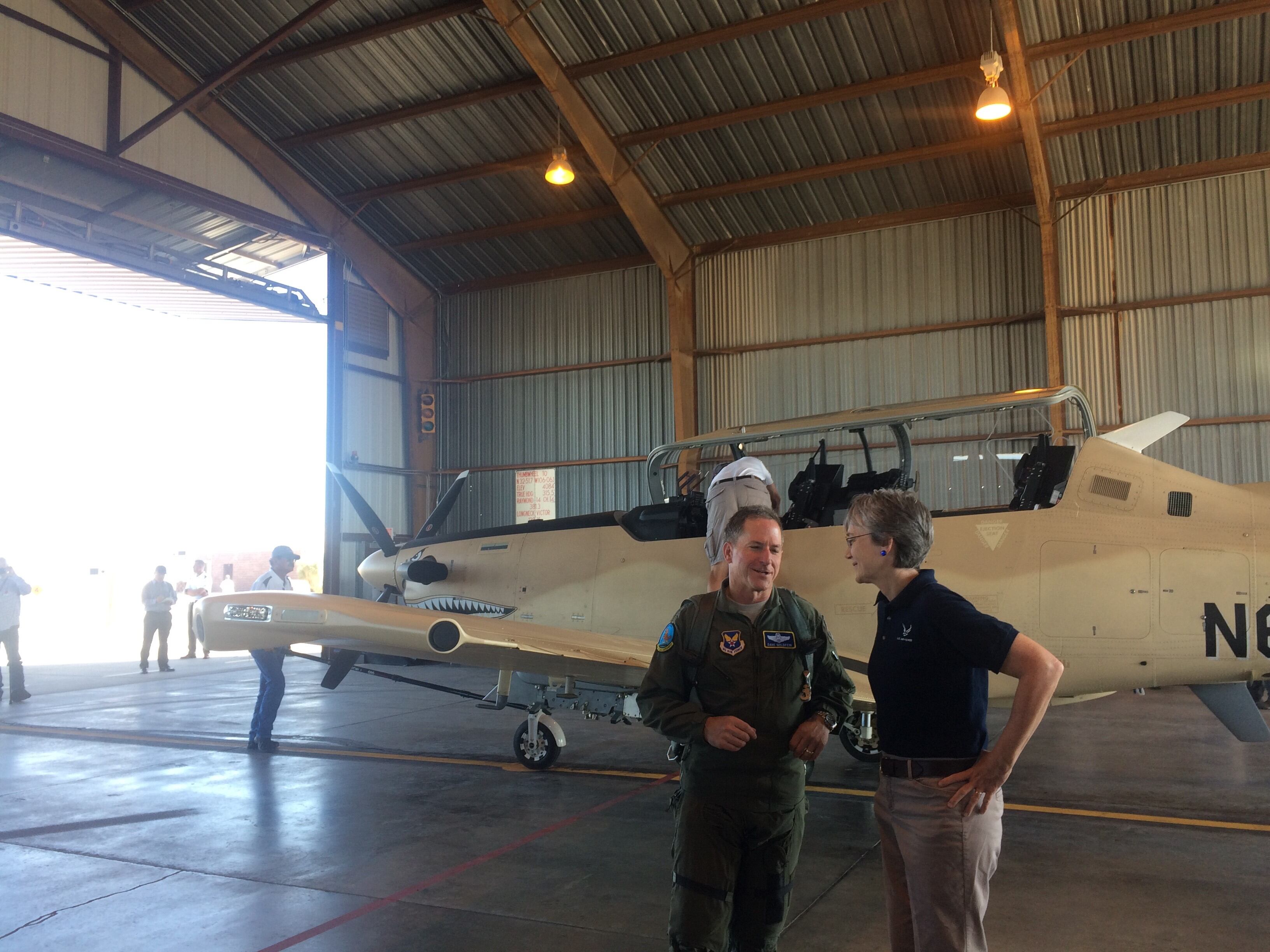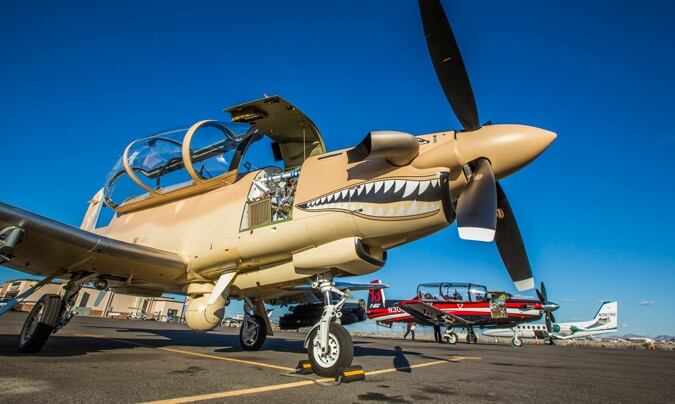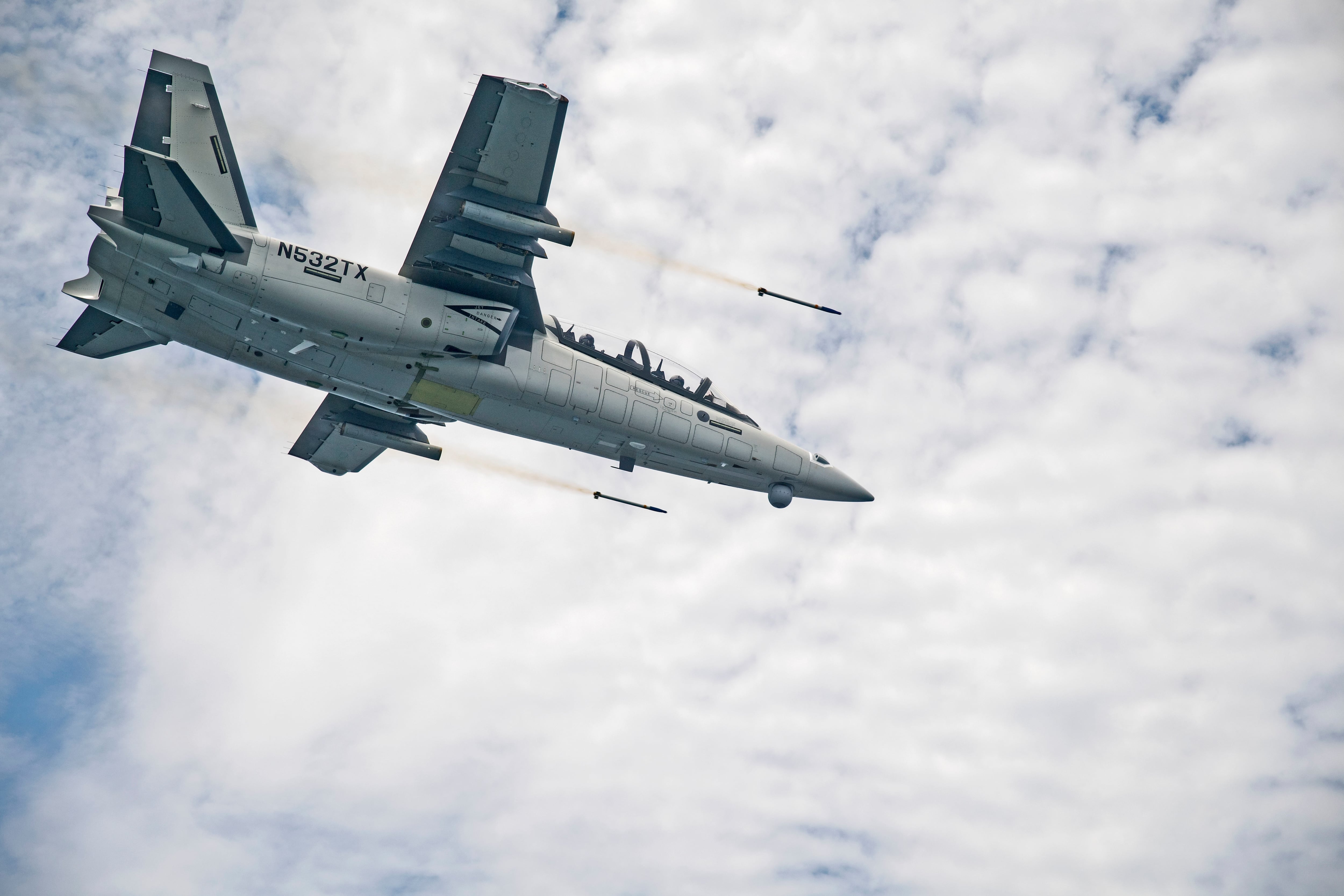HOLLOMAN AIR FORCE BASE, N.M. — The U.S. Air Force is about two weeks into a light attack aircraft experiment where it is evaluating four off-the-shelf planes: Air Tractor and L3’s AT-802L Longsword; Sierra Nevada Corp. and Embraer’s A-29 Super Tucano; and the Scorpion jet and AT-6 Wolverine, both from Textron.
For industry, it is an opportunity to prove the viability of their aircraft to a service that, for the past two decades, has been more interested in exquisite stealth jets than the inexpensive, simply designed workhorses at Holloman Air Force Base, N.M.
For the U.S. Air Force, it’s a chance to prove it can use innovative contracting tools to procure products faster, although U.S. Air Force officials during the Aug. 9 media day were quick to remind reporters that no program-of-record for light attack aircraft existed then.
“It’s an experiment. We’re learning from this. We want to meet the needs of permissive environments at lower costs; we want to develop capabilities for uncontested environments and use this experiment to evaluate the military capabilities of these kinds of aircraft,” U.S. Air Force Secretary Heather Wilson said during a speech at Holloman AFB. “The empirical data that we gather from this this experiment will inform strategic decisions.”
RELATED

So far, the AT-6 Wolverine and A-29 Super Tucano have begun their flight assessment period, although all four aircraft are on the ground at Holloman AFB and training activities continue for Scorpion and Longsword. Company officials from Sierra Nevada Corp. and Textron told Defense News earlier this week that the AT-6 and A-29 are flying about two times daily.
What to expect in this experiment:
Although the U.S. Air Force pilots and weapon system operators engaged in the experiment were not made available to the media, Lt. Col. Robert Odom, 704th Test Group deputy commander, outlined the broad strokes of what the service will be evaluating:
- The ability to find, fix, track and target
- Datalink operability
- Weapons delivery and accuracy
- Accuracy of flight manual predictions
- Flying/handling qualities of the plane
- Functionality of its systems
- Whether the aircraft is suitable for operations in environments like the Middle East
- The platform’s visual, infrared and acoustic signatures
The U.S. Air Force is using aircrew surveys to measure the effectiveness of some criteria, such as an aircraft’s targeting capability or its compatibility with night vision devices. Other data is more quantitative, like the range scores for ballistic and guided bomb employment, Odom said.
Test pilots will fly up to five evaluation performance sorties — some day and some night — across eight different mission sets, ranging from basic air interdiction to a more complex close air support scenario involving joint terminal attack controllers on the ground calling in strikes, he said.
The aircraft will also fire inert unguided munitions — including .50 caliber rounds, 2.75 mm rockets and dumb bombs — as well as precision-guided weapons such as laser-guided rockets and bombs.
RELATED

The final event will test the airplane’s ability to operate in austere environments, Odom said. During that scenario, operators will have to do a maintenance “turn” of the aircraft using only basic tools, a test that includes shutting the aircraft down, reloading fuel and then taking off. The plane will then undergo an assessment of its ability to operate from unpaved airfields.
After the exercise, the U.S. Air Force will take all of its data and turn it into four reports, one for each of the aircraft offerings. If service leaders are convinced that some of the planes can hack it in an operational setting, they will probably approve a combat demonstration in the Middle East, Wilson told reporters.
However, past that, a major problem emerges: Will the U.S. Air Force have the money to start a program of record?
Lt. Gen. Arnold Bunch, the service’s top uniformed acquisition official, described a light attack aircraft program as “additive,” meaning that the service would require more funding than would be allowed under current budget limits.
“We would not sacrifice the modernization of the fourth- or the fifth-generation procurement fleets to be able to go do this, because we’ve got to advance to be able to address the upper-scale adversaries, so we have to keep that on track,” he said. “We would need additional money.”
What’s happened so far:
On the ground at Holloman AFB, industry is eager for feedback from the U.S. Air Force that could help it tailor products for future sales opportunities or a possible program.
The experiment is the first time the AT-6 Wolverine has been in the hands of an operator that is “really current and up to date on employment,” Tom Webster, Textron Aviation’s regional director of new aircraft and aftermarket sales, told Defense News in an Aug. 7 interview. That day, the Wolverine had conducted a “RESCORT” mission, which involves escorting a helicopter that is conducting a rescue mission and employing munitions as necessary.
“What we’ve learned there is our ability to work with and coordinate with the helicopters, from our perspective … is probably more comprehensive” than previously expected, he said.
“When a fighter pilot or attack pilot comes to me and says, ‘My God, this airplane is fun to fly,’ that’s a very good sign,” added Webster, who is a former F-16 pilot. “When you fly an airplane like the F-16 … you are very fortunate in many ways. Your job, although challenging, is a lot of fun. So that kind of feedback I take it very positively.”
RELATED

The A-29 Super Tucano is “holding up well” through the day and nighttime scenarios it has been tasked with so far, said Taco Gilbert, SNC’s senior vice president for intelligence, surveillance and reconnaissance.
“Most of the fights so far have been, to the best of our knowledge, pretty straightforward, nothing really unusual,” he said. “We are looking forward to what some would see as some more demanding aspects of the evaluation, things like the unimproved field landings. We understand that most of that has been pushed to the very end of the evaluation, but nonetheless, we’re anxious to get into those aspects.”
Gilbert noted that the U.S. Air Force has been careful not to give companies too much feedback on the performance of the aircraft and how well it has been doing at meeting its criteria.
“I think part of that is that this is a very open-ended experiment,” he said. “If I were the Air Force, I would want the ability, as I learned more in an experiment, to alter my experiment objectives, which gives me some sense of understanding and appreciation for the fact that they’re not giving me the criteria.”
The Scorpion and Longsword will begin their flight assessment during the back half of the experiment. Textron’s Scorpion had flown eight familiarization flights when Bill Harris, the company’s vice president of Scorpion jet sales, spoke with Defense News on Aug. 7.
“We wanted to see how it handled with a weapons load on the wings, so we did that … this morning,” he said. “The actual evaluation is coming up here really soon, as well as some of the weapons employment sorties.”
L3 and Air Tractor’s AT-802L was the final aircraft announced for the experiment and didn’t arrive at Holloman AFB until Aug. 4, Tom Menker, Air Tractor’s business development and government relations representative, said in an Aug. 8 interview. U.S. Air Force pilots have begun ground and classroom training, with the first familiarization flights scheduled for Thursday.
“They are going to be learning about the airplane,” he said. “The dialogue will be: What is the mission system? The weapon system? What does that look like today as it exists on the Holloman ramp? What inputs might the Air Force have in terms of how might our product be improved to meet combatant commander requirements?”
“So it’s definitely a two-way dialogue, because the aircraft are — in many ways — an unfinished product,” he continued. “So that’s something that we are eager to hear from these U.S. Air Force test pilots, their perspective on the product.”
Valerie Insinna is Defense News' air warfare reporter. She previously worked the Navy/congressional beats for Defense Daily, which followed almost three years as a staff writer for National Defense Magazine. Prior to that, she worked as an editorial assistant for the Tokyo Shimbun’s Washington bureau.








